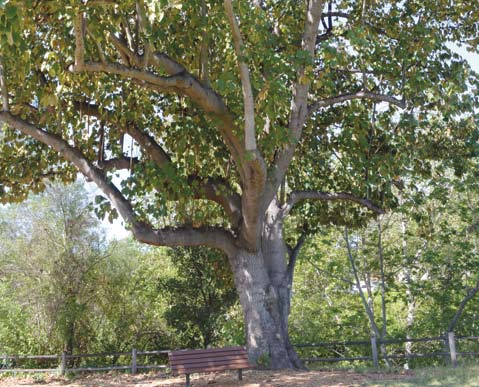Three Trees Declared National Champions
Goleta Valley Monkey's Hand and Santa Barbara Sweetshade Trees Biggest of Their Kind

Some of the biggest trees in the entire world grow in Santa Barbara County, and as of this month, we can now officially boast three more.
The monkey’s hand tree in Goleta Valley’s Lassen Open Space, a sweetshade tree on the corner of Castillo and Dibblee streets in Santa Barbara, and a lemon-scented gum in the Winchester Canyon region of Goleta were recently declared national champions, meaning that they are the biggest specimens of their kind in the whole country. The term “champion tree” was developed by conservation nonprofit American Forests to designate exemplary trees, and the county now can count nine in its king’s court.
The City of Santa Barbara alone contains nearly 500 species of trees, making it “probably one of the most diverse urban forests in the world,” said Matt Ritter, who is director of the Cal Poly S.L.O. Plant Conservatory and oversees the California Registry of Big Trees. Ritter measured and nominated the sweetshade tree alongside Randy Baldwin, the general manager of San Marcos Growers.
The county’s other champion trees include a toyon in S.B., an Australian willow and a California sycamore in the City of Goleta, a strawberry tree in the Goleta Valley, a pair of co-champion dragon trees in Santa Barbara and Montecito, and a Torrey pine in Carpinteria. The famous train station Moreton Bay Fig was once a champion but has since been dethroned by a bigger one in Glendora.
The lemon-scented gum, the area’s most recently designated champion, rooted down in the area 128 years ago when it was planted by Ellwood Cooper on his ranch in 1887. The other two new champion trees have enigmatic origins; no one knows who exactly planted either one. Santa Barbara Deputy Director of Parks Paddy Langlands estimates the monkey’s hand tree to be about 60 years old, while Ritter puts the sweetshade at 108 years old, predating the streets it shades. Whoever planted them had “tremendous foresight,” says Goleta tree consultant Kenneth Knight, who measured the monkey’s hand tree and nominated it for championship status. Knight is currently president of the urban forestry nonprofit Your Children’s Trees and former director of Goleta Valley Beautiful. He recently conducted the very first tour of the region’s champion trees.
Something of an S.B.-area Lorax, Knight cares deeply for these trees and worries about their future. Though some, like Carpinteria’s towering Torrey pine, are thoroughly protected, others, like the ancient sycamore in a developing lot adjacent to an Old Town Goleta Nissan dealership, lie in an ambiguous public-private zone without any special protection. Knight fears the tree could be truncated or damaged when the lot becomes developed by the City of Goleta. “We are looking at the endangerment of this tree,” he said.
Barbara Massey, who serves on Goleta’s Public Tree Advisory Commission, said the city is working on a tree-protection ordinance. She could not say whether or not the champions would be covered by the ordinance but did say further protection is “definitely something we feel is necessary to have.”
With an ever-growing urban population and an ever-dwindling water supply, these long-surviving trees do face uncertain futures even with protections. Nonetheless, the champion title and further public awareness will go a long way in keeping them alive, said Ritter, who explained, “It’s harder to cut down a tree that everybody knows about.”



